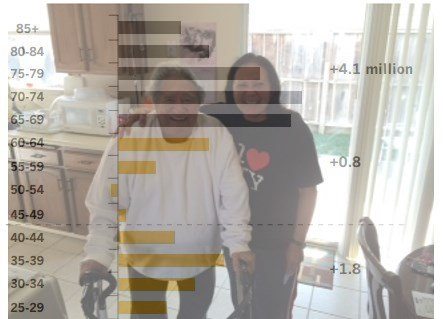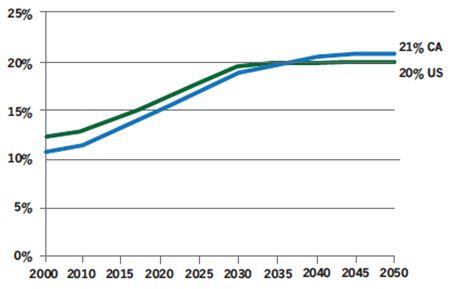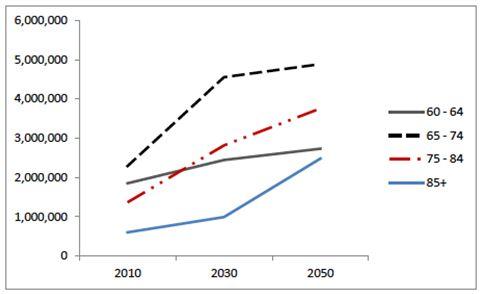Labor & Economy
A Silver Tsunami Hits the Golden State

Thousands of aging and disabled Californians, along with their home care providers, have been on edge to see if a seven percent cut in home care services will be restored in the state budget, as Jim Crogan details for Capital & Main. But this year’s tug-of-war at the margins of the state budget is just a foreshadowing of serious struggles to come over the next 15 years as a tidal wave of new seniors changes the face of our state.
Despite California’s falling birth rates, the state’s population has grown faster and stayed younger than the country on average, thanks to immigration. But the outsized numbers of baby boomers has begun to outweigh those moving in, and it will leave us with a much older population.
Listen to Podcast: Dan Braun Interviews IHSS Home Care Recipient and Her Caregiver
The number of Californians over 65 will nearly double by 2030 (from 4.3 million in the 2010 Census to 8.6 million according to projections by the California Department of Finance), thanks to increasing longevity and the aging of our biggest population bubble: the baby boomers. By 2030, seniors will have gone from one in 10 Californians to almost one in five.
Share of Population 65+
Data from California Department of Finance and U.S. Census Bureau
Chart and analysis from Stanford Center on Longevity, 2012
The increase in the age and number of seniors will mean that meeting their needs becomes a much more central function of our economy and government. Social Security will require careful stewardship as more Americans draw on it. Pension systems have already been adjusting, due to actuarial projections including demographic changes. Meanwhile, private retirement savings lag quite a ways behind projected need.
As baby boomers deal with the health and mobility challenges inherent in aging, we will also need to figure out how we put resources into their care. (The California State Plan on Aging is a good place to look for more projections and details on state programs.) Medicare and other health spending – already increasing in the last few decades – will be a significantly greater share of federal, state, and county budgets. Health facilities and the health care workforce will need to expand in ways to match needs.
The In-Home Supportive Services program (IHSS) provides supportive and health care to thousands of seniors at a much cheaper rate than nursing homes. While a seven percent cut was at issue in the last couple of state budgets, it could require a larger share of the budget in future years. Making wider and more efficient use of this system could be a central tactic in meeting the increased needs of the aging. Investment and innovation in the IHSS system might be the most promising use of resources.
All of these needs will have to be met by a state and economy with fewer workers relative to the population they support. Baby boomers didn’t make babies at the same rate as those before them, and neither have their children. As boomers proceed further into their senior years and life expectancy improves, the greatest growth will be among the very old (over 85), who are also the most likely to have chronic health issues and need support.
Age 60+ Population Growth Projections
From the California State Plan on Aging, California Department of Aging
In 2010 there were 4.6 working-age Californians per senior; by 2030, there are projected to be just 2.5 working-age Californians per senior (working age is 25-64, from California Department of Finance). With a higher share of those workers employed in directly meeting the health and other needs of seniors, it will leave even smaller relative numbers working in the rest of the economy. Projecting what the economy will look like in future decades is more difficult than projecting demographics, but the relative pull on our economy by seniors will surely help shape it.
The graying of the Golden State will bring with it a variety of challenges and strains on our society, economy and government budgets. It will require some major shifts in our expectations and responsibilities, and it’s time to start figuring out how we adjust. The full impact of our aging population won’t be seen for a few years yet, but the waves of change are already at our shores.

-

 Latest NewsDecember 8, 2025
Latest NewsDecember 8, 2025This L.A. Museum Is Standing Up to Trump’s Whitewashing, Vowing to ‘Scrub Nothing’
-

 Striking BackDecember 4, 2025
Striking BackDecember 4, 2025Home Care Workers Are Losing Minimum Wage Protections — and Fighting Back
-

 Dirty MoneyDecember 3, 2025
Dirty MoneyDecember 3, 2025Trump’s Anti-Climate Policies Are Driving Up Insurance Costs for Homeowners, Say Experts
-

 Child FarmworkersDecember 5, 2025
Child FarmworkersDecember 5, 2025To Protect Underage Farmworkers, California Expands Oversight of Field Conditions
-

 Column - State of InequalityDecember 4, 2025
Column - State of InequalityDecember 4, 2025Can California Claw Back Some Medi-Cal Care?
-

 Latest NewsDecember 10, 2025
Latest NewsDecember 10, 2025Capital & Main, L.A. Times Win Sidney Award for Reporting on Child Farmworkers
-

 StrandedDecember 9, 2025
StrandedDecember 9, 2025Giving Up on the Dream: Asylum Seekers Try Other Options in Mexico
-

 Locked OutDecember 16, 2025
Locked OutDecember 16, 2025This Big L.A. Landlord Turned Away People Seeking Section 8 Housing



